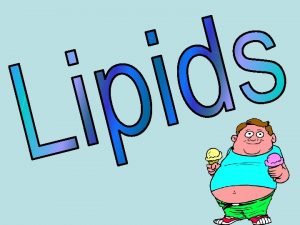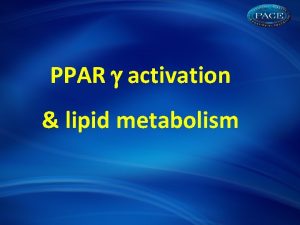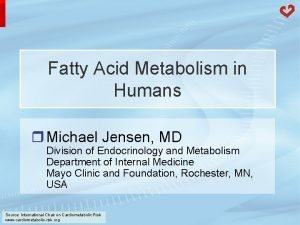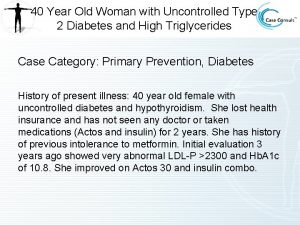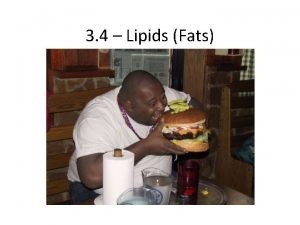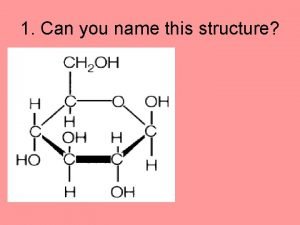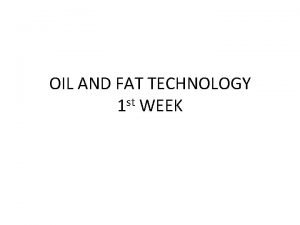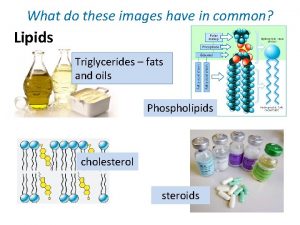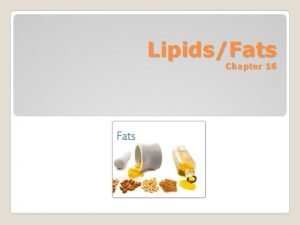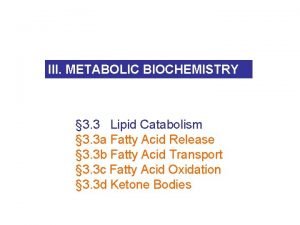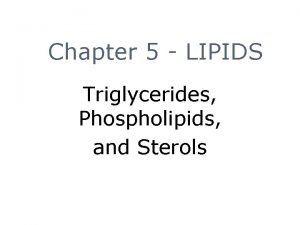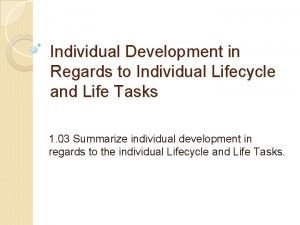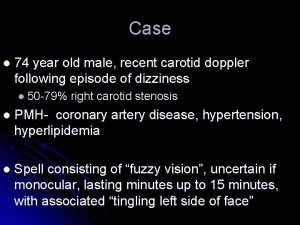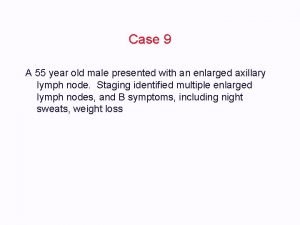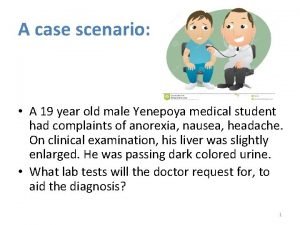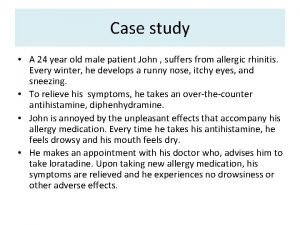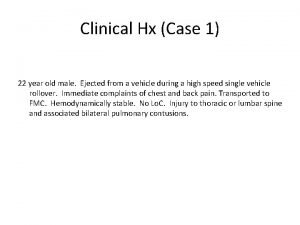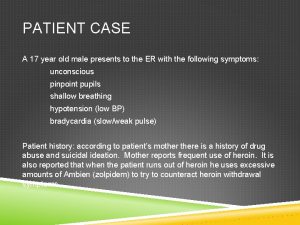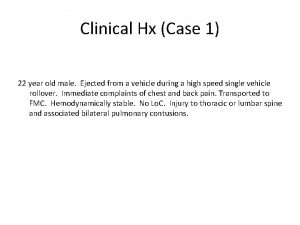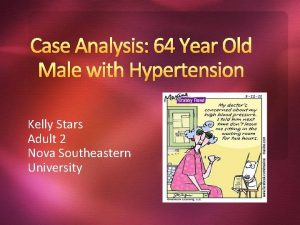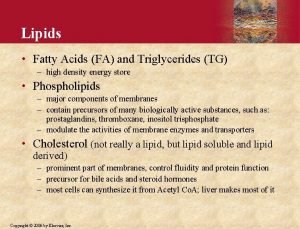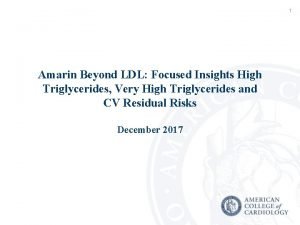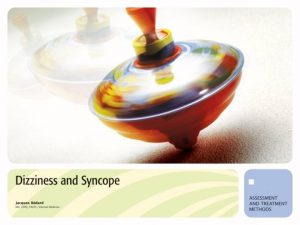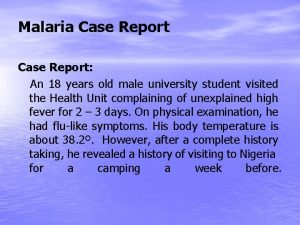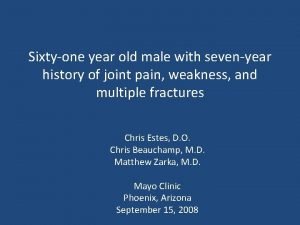42 Year Old Male with High Triglycerides Case





























- Slides: 29

42 Year Old Male with High Triglycerides Case Category: Primary Prevention History of present illness: 42 year old male with history of high triglycerides, also family history of type 2 diabetes. He complains of abdominal weight gain of recent despite no change in diet. He also has had depression and anxiety. Recently diagnosed with vitamin D deficiency (not taking supplements). Diet is high in processed foods.

Patient Information Age Gender 42 Male Height (in) Weight (lbs) BMI 73 213 28. 10 Waist Circumference (CM) (in) Exercise 36 Light Smoking Allergies Alcohol No Sulfa Occasional wine BP Systolic (mm/Hg) BP Diastolic (mm/Hg) 120 78 Pulse Rate (beats/min) Fasting Status 88 NF

Patient History Allergies Surgical History Right hand biopsy Family History Father Age 75; prostrate cancer; former smoker Mother Age 72; HTN Brother Age 48; type 2 diabetes; mildly obese (lost weight); smoker Sister Age 45; healthy

Current Medications Current Medication Prior to this Visit Lamictal XR 200 mg 1 BID Remeron 15 mg 1 at HS Alprazolam 1 mg As needed Nasonex Whey protein As needed 20 g Twice daily

Labs Worth Noting – No Medications Lab Test Normal Range Patient Value LDL Particle (LDL-P) (nmol/L) <1000 2121 VERY HIGH LDL-C (mg/d. L) <100 133 HIGH HDL-C (mg/d. L) >40 48 Triglycerides (mg/d. L) <150 297 Total Cholesterol (mg/d. L) <200 219 Small LDL-P (nmol/L) <850 1596 VERY HIGH LP-IR Score (0 -100) <45 71 HIGH Non-HDL-C (mg/d. L) <130 171 Vitamin D 25 -OH (ng/m. L) >30 29 ALT (U/L) Up to 33 45 Hb. A 1 c (%) <5. 6 5. 0 Insulin (u. IU/m. L) 3 -9 22 HIGH

Questions to Consider • Question 1: High triglycerides are very impacted by diet and lifestyle. Ask about alcohol use and if on a high carb diet? Motivation to make changes? • Question 2: Psychiatric medication history? Some medications are more likely to produce metabolic abnormalities, insulin resistance and high triglycerides. • Question 3: Prior medication trials for dyslipidemia or glucose abnormalities? NONE • Question 4: Any symptoms of polyuria, polydipsia, “hypoglycemia”, craving carbs/sugar or fatigue? • Question 5: Has hypothyroidism been ruled out as a secondary cause of high triglycerides?

Labs – No Medications

Labs – No Medications

Labs – No Medications

Labs – No Medications

Labs – No Medications

NMR Lipo. Profile • Insert NMR Lipo. Profile 08172011 DR 69 Insert

Initial Treatment & Management • Low carb diet and increased exercise recommended to improve insulin resistance syndrome. • Start Lovaza 4 g/daily for hypertriglyceridemia and low omega 3 index. • For vitamin D deficiency, start vitamin D 3 5000 IU/day. • Diet modifications recommended for high trans fat index. Avoid all partially hydrogenated oils (trans fat) and high fructose corn syrup.

Discussion Problem Issues Treatment Options Familial Combined Hyperlipidemia (1) Hyperlipidemia leads to atherosclerosis leading to increased risk of heart attack and stroke. (2) Total cholesterol and triglycerides are high (219 and 297). (3) The most important number to consider is LDL-P is high (2121) and it is primary driver of atherosclerosis leading to heart attacks and stroke. LDL-C is frequently not an accurate estimate of LDL-P goal is based on risk. Elevation may be due to insulin resistance. (4) There is a family history of diabetes. (5) Genetic and inflammatory markers are normal. Lifestyle: (1) Low carb diet and increased exercise. Medications: (1) Start Lovaza 4/g daily to reduce triglycerides and due to a low omega 3 index (3%). High doses of Lovaza may raise LDL-C, but overall LDL-P , Apo B, and non HDL should decrease.

Discussion Problem Insulin Resistance Syndrome Issues Treatment Options (1) Insulin is high (22 ). (2) Patient has history of ‘crashing’ after meals. (3) Insulin resistance is also noted on NMR profile. (4) LDL-P / small LDL-P levels are very high (2121 and 1596) and there is a surplus of HDL / large VLDL-P (48 and 3. 4). (5) Once impaired fasting glucose or impaired glucose tolerance has occurred, there has already been a loss of 60 -65% beta cell function. (6) In early stages of metabolic syndrome hyperinsulinemia occurs to compensate for insulin resistance which causes blood sugar to drop at times as insulin is being secreted erratically. At this point, it is not uncommon to see normal or even low glucose. Hb. A 1 c was 5. 0. (1) Treatment with lifestyle changes and medications are important to reduce the progression to diabetes. Initially treat with diet modification and increased exercise. (2) Could be candidate for metformin in future but currently has borderline creatinine so would be relatively contraindicated at this time and lifestyle treatment should be trialed first. Men creatinine >1. 5 and women >1. 4 contraindicated for use of Metformin.

Discussion Problem Issues Treatment Options Vitamin D Deficiency (1) Vitamin D levels are low (29). (2) Deficiency is associated with increased risk for CVD, fatigue, depression, muscle aching, and cancer. (1) Start vitamin D 3 5000 IU/day. Take D 3, not D 2. Choose an oil based capsule rather than a tablet for better absorption. Elevated Transaminases (1) Elevated transaminases may indicate fatty liver disease. (1) Will monitor. No need for treatment or work up unless levels are >3 time and consistently elevated. (2) Treatment of hyperlipidemia will improve underlying fatty liver if present. Low Omega 3 Index (1) Low omega 3 index associated with increased cardiovascular risk. Index is 3%. Lifestyle: Consume more omega 3. Highest sources come from Atlantic salmon, herring, mackerel, or bluefin tuna. Medications: (1) Start Lovaza 4/g daily.

Discussion Problem High Trans Fat Index Issues Treatment Options Lifestyle: (1) Avoid partially hydrogenated oil which raises triglycerides and LDL and lowers HDL. Good fats such as olive and canola oil are better choices. Use in moderation as the calories can contribute to weight gain. (2) Minimize high fructose corn syrup. Eat complex carbs like vegetables and whole grains if consuming carbs.

Follow Up on Lovaza 4 g and Vitamin D 5000 IU • Familial Combined Hyperlipidemia – Improved. – On Lovaza 4 g/day total cholesterol had dropped from 219 to 162; LDL-C reduced to 104 from 133; triglycerides lowered from 297 to 55; non-HDL-C now 116 from 171. HDL is unchanged. LDL-P lowered from 2121 to 1557 and Apo B dropped from 111 to 82. – Sterol testing showed oversecretion of cholesterol in liver, there is no evidence of overabsorption. Adding a statin may be beneficial at this time. On NMR analysis, insulin resistance improved. IR score dropped from 71 to 42. – Discussed risk/benefit of starting a statin in primary prevention. He wishes to be aggressive with prevention efforts. Start Livalo 4 mg/day. Livalo chosen based on lack of p 450 3 A 4 interactions and current use of several psychiatric medications. The statin will give anticlotting and anti-inflammatory benefits which will help stabilize plaque and prevent rupture. If muscle aching occurs, take CO Q 10 supplement 300 -600 mg/day in capsules containing oil. Note: no outcome data are available to support routine use, but patients often experience improvement with their symptoms.

Follow Up on Lovaza 4 and Vitamin D 5000 • Insulin Resistance Syndrome – Improved. – Hb. A 1 C is now 4. 7 from 5. 0. – Insulin resistance improved overall on all testing (insulin norrmaiized and NMR insulin resistance markers improved) with Lovaza 4 g/day and low carb diet. No weight change to explain benefit seen. • Vitamin D Deficiency – Improved. – Levels increased from 20 to 54 on 5000 IU/day of Vitamin D 3. Continue supplements. • Elevated Transaminases – Improved. – Treatment of lipids has improved levels. – Normalized on Lovaza 4 g/day. • Omega 3 Index – Improved. – Level is up to 7% from 3%. – Continue current diet and omega 3 supplements.

Follow Up on Lovaza 4 and Vitamin D 5000

Follow Up on Lovaza 4 and Vitamin D 5000

Follow Up on Lovaza 4 and Vitamin D 5000

Follow Up on Lovaza 4 and Vitamin D 5000 Sterol testing shows evidence of oversynthesis of cholesterol. This pattern suggests that a genetic disorder is likely present and a statin would be appropriate if LDL-P/Apo B are elevated.

Follow Up on Lovaza 4 and Vitamin D 5000 Liver enzymes normalized as expected with treatment.

Follow Up on Lovaza 4 and Vitamin D 5000

NMR Lipo. Profile • Insert NMR Lipo. Profile 01252012 DR 69 Insert

Other Clinical Pearls • Psychiatric medications to avoid (if possible) that may increase triglycerides: – Zyprexa (Olanzapine) – Clozaril / Fazaclo (Clozapine) – Risperdal (Risperidone) – Seroquel (Quetiapine)

Case Summary High Triglycerides 1 st Visit Follow Up Goal Medication None Lovaza 4, Vitamin D 3 5000 LDL-P (nmol/L) 2121 1557 <1000 LDL-C (mg/d. L) 133 104 <100 HDL-C (mg/d. L) 48 46 >40 Triglycerides (mg/d. L) 297 55 <150 Total Cholesterol (mg/d. L) 219 162 <200 Small LDL-P (nmol/L) 1596 653 <850 LP-IR Score (0 -100) 71 42 <45 Non-HDL-C (mg/d. L) 171 116 <130 Vitamin D 25 -OH (ng/m. L) 29 54 >30 ALT (U/L) 45 24 Up to 33 Hb. A 1 c (%) 5. 0 4. 7 <5. 6 Insulin (u. IU/m. L) 22 4 3 -9

References • • Cromwell WC, Otvos JD, Keyes MJ, et al. LDL particle number and risk of future cardiovascular disease in the Framingham offspring study – implications for LDL management. J Clin Lipidol 2007 Dec; 1(6): 583 -92. . Grundy SM, Cleeman JI, Merz CN, et al. Implications of recent clinical trials for the National Cholesterol Education Program Adult Treatment Panel III guidelines. Circulation. Jul 13 2004; 110(2): 227 -39. Kolovou GD, Anagnostopoulou KK, Kostakou PM, et al. Primary and secondary hypertriglyceridaemia. Curr Drug Targets. Apr 2009; 10(4): 336 -43. Mc. Kenney JM, Mc. Cormick LS, Weiss S. A randomized trial of the effects of atorvastatin and niacin in patients with combined hyperlipidemia or isolated hypertriglyceridemia. Collaborative Atorvastatin Study Group. Am J Med. Feb 1998; 104(2): 137 -43. National Cholesterol Education Program. Executive Summary of The Third Report of The National Cholesterol Education Program (NCEP) Expert Panel on Detection, Evaluation, And Treatment of High Blood Cholesterol In Adults (Adult Treatment Panel III). JAMA. May 16 2001; 285(19): 2486 -97. Roth EM, Bays HE, Forker AD, et al. Prescription omega-3 fatty acid as an adjunct to fenofibrate therapy in hypertriglyceridemic subjects. J Cardiovasc Pharmacol. Jul 10 2009. Triglycerides and Cardiovascular Disease: A Scientific Statement form the American Heart Association Circulation published online Apr 18, 2011 DOI: 10. 1161/CIR. 0 b 013 e 3182160726 Circulation published online Apr 18, 2011; Llorente M and V Urrutia. Diabetes, psychiatric disorders, and the metabolic effects of antipsychotic medications. Clinical Diabetes Jan 2006 24(1): 18 -24.
 A 23 year old male experienced severe head trauma
A 23 year old male experienced severe head trauma Triglycerides formation
Triglycerides formation Dyslipidaemia
Dyslipidaemia Naming triglycerides
Naming triglycerides Saponification of triglycerides
Saponification of triglycerides Fatty acid oxidation
Fatty acid oxidation Metformin triglycerides
Metformin triglycerides Triglycerides are composed of
Triglycerides are composed of Monomer in lipids
Monomer in lipids Triglycerides treatment
Triglycerides treatment Iodine number calculation formula
Iodine number calculation formula What do these images have in common?
What do these images have in common? What are triglycerides
What are triglycerides Brain capillary
Brain capillary Triglycerides phospholipids and sterols
Triglycerides phospholipids and sterols Best worst and average case
Best worst and average case Year 6 leavers assembly poem
Year 6 leavers assembly poem What should my heart rate be
What should my heart rate be The great gatsby activities
The great gatsby activities 42 year old woman
42 year old woman Massachusetts iep sample
Massachusetts iep sample Average height of a 3 year old in centimeters
Average height of a 3 year old in centimeters 9-year-old physical development
9-year-old physical development Eight year old hyphen
Eight year old hyphen Average weight for 8-year-old boy
Average weight for 8-year-old boy 8 yr old girl weight
8 yr old girl weight 9-year-old physical development
9-year-old physical development Brigance test for 4 year old score
Brigance test for 4 year old score Brigance scoring chart
Brigance scoring chart One year old marcus turns away in disgust
One year old marcus turns away in disgust

